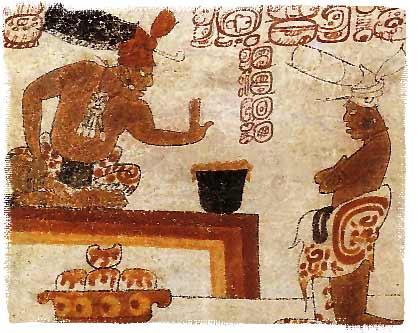Anyone who follows this blog knows that I'm no chocolate lover. Being fond of history though, you can't always escape. Chocolate is the basic ingredient of some of the loveliest cakes in the world: Sachertorte, Devil's food cake, Rigó Jancsi... So this is the first of two posts that I will dedicate to chocolate.
Cacao was used by the Maya thousands of years ago. Trees grew up in
their yards so they would regularly enjoy a bitter chocolate drink, supposedly a remedy with aphrodisiac powers. It was as important to them as wine, ale or
mead have been to Europeans. The beans were also fermented, resulting in liquor that might have tasted worse even than Chocolate bitters! When
the Aztecs conquered part of the Maya lands in the 15th century, they
naturally fell in love with cacao. They adapted the recipe, enhancing chocolate flavor with vanilla, spices & honey. This was
more or less how the Spanish nobility also enjoyed their chocolate. 'Chocola-tl' was prepared with cold water unlike the Maya concoction that was normally served hot. The
Aztecs valued cacao beans very much, especially since the plant
would not grow in Mexico and even used them as currency. They also believed
that cacao was the privilege of gods and that Quetzalcoatl had been
expelled from their company because he shared the drink with the mortals. Chocolate was also used in rituals that involved human sacrifice.
The Europeans learnt native American habits from the returning 'conquistadores'. Tobacco and chocolate quickly became addictions, originally linked to power and wealth. The middle class was also gradually introduced to such luxuries between 1600 and 1800 when the slave trade was at its peak. Chocolate, in particular, was said to be the food of the gods. Derived from the Greek words θεός=god and βρώμα=food, 'theobroma' and theobromine are the Latin names for the cacao plant and for the essential nutrient of the cacao bean. After the chocolate mill was invented, every household could afford to make a chocolate beverage. The Experienced English Housekeeper (1769) gave instructions in the chapter of "possets, gruels &c." for a splendidly frothy drink that was achieved by repeatedly milling the cacao beans and pouring the water from high. Elizabeth Raffald's chocolate looked like the Maya original and was also served cold but tasted more like the Aztec version because it used sugar. Other 18th century recipes were flavored with cinnamon and/or served hot. With time, creamier versions prevailed on both sides of the Atlantic. Mrs. Rorer's Philadelphia Cookbook (1886) used milk instead of
water. No milling was needed as the cacao beans were already processed. The desired consistency was obtained by whisking or churning. A beverage similar to Elizabeth Raffald's was prepared with cacao nibs and water. The mixture was boiled for 2 hours and thickened/sweetened with cream.
Elizabeth Raffald's chocolate
Pour 1 cup of boiling water over 3tbsp (=22.5g) of raw cacao nibs. Mill, let stand overnight. Mill, add sugar to taste. Mill and pour into a cup from high to make a froth.
Sarah Tyler Heston Rorer's chocolate
Pour 1 cup of hot milk over 1tbsp (=10g) of grated chocolate. Add 1 1/2tsp of sugar and whisk or churn until thick. Serve in a cup.
Another way
Boil 2tbsp (=15g) raw cacao nibs with 2 cups of water for two hours. Add 1/4 cup (=60g) heavy cream. Whisk or churn and pour into a cup.
CHOCOLATE DRINK
This recipe is slightly adapted from Elizabeth Raffald's own because the chocolate is not sweetened. Making a froth was not possible either: there was no coffee grinder at home in which to mill the cacao beans so I resorted to crushing and pressing. The resulting drink tastes incredibly bitter -even for hardcore chocolate fans- but the aftertaste can be improved (or enhanced) with a biteful of very sweet or salty, natural, foods.
I n g r e d i e n t s
3tbsp (=22.5g) raw cacao nibs
1 cup boiling water
M e t h o d
Pour the water over the grains. Let soak for 6-8 hours. Strain over a bowl, keeping the water. Grind or pulse the cacao nibs. Boil the water, add the paste and stir. Pour into a cup and enjoy.


Comments